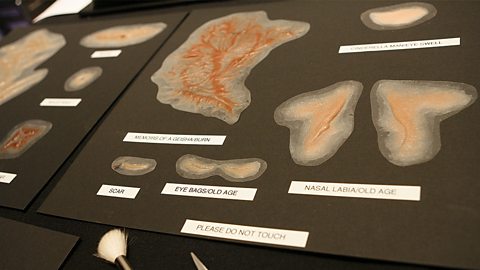Adornments, hair, make-up, shape and texture
Other aspects to consider when designing a costume include:
- adornments
- hair and make-up
- practicalities
- shape
- texture
Adornments
Adornments are the accessories that are added to a costume, eg jewellery, handkerchiefs and bags. The scale or size of adornments needs to be considered as, depending on where they are sitting, it can be difficult for the audience to see details. Adornments may be accentuated to make them clearly visible.
Hair and make-up
Hair and make-up are also aspects of costume design. Simple make-up is often used to help pick out the performerâs facial features under bright lighting, but make-up serves many other functions. For example, it is used to:
- create special effects such as cuts and bruises
- help a performer appear older, eg to create wrinkles
- change facial features, eg through the use of prostheticAn aspect of make-up design where synthetic materials are used to alter a human's physical appearance.

Practicalities
The practicalities of a costume must also be considered when working on a design. Some productions can require quick costume changes between scenes, and a costume designer will have to find ways to help this, eg by using Velcro rather than buttons. Comfort and freedom of movement should be considered as well as weight when using different materials and fits.
Shape
Costume can be used to give a performer a different physical shape, eg a body suit may be worn to make a performer appear larger. The outline created by a costume on a performer is called a silhouetteThe outline shape of a costume on a performer.. Different silhouettes are associated with different fashions throughout history, eg shoulder pads are reminiscent of 1980s power dressingPopular in the 1980s, the practice of dressing in a way that enables a person to establish their authority, particularly within business..
Texture
The texture of the fabric used on a costume can provide the audience with information about a playâs context or insight into a character. For example, a soft cashmere cardigan in pastel tones can suggest that a character is warm and caring, whereas leather and suede in dark colours can appear more threatening. It is important to consider how textured surfaces react differently under stage lighting, eg a shiny finish like satin is very reflective under lights.